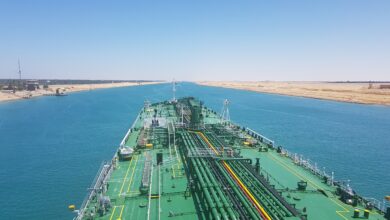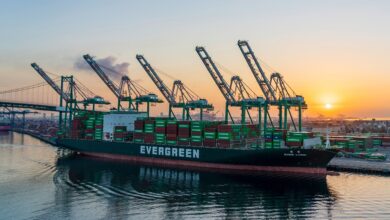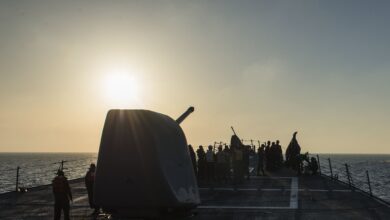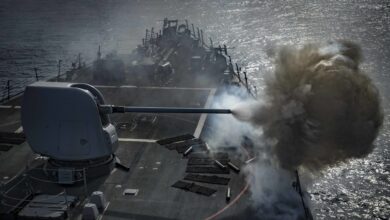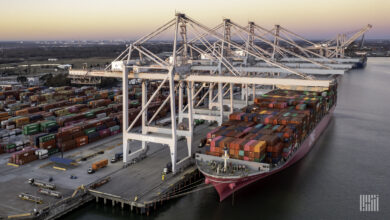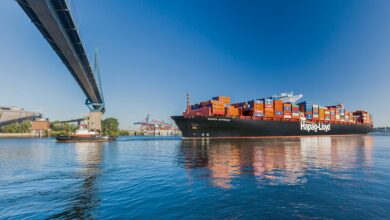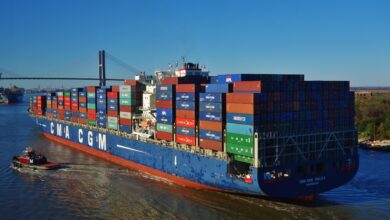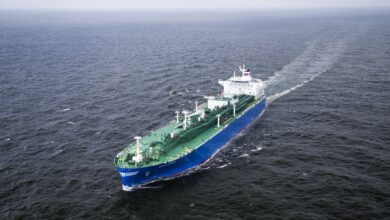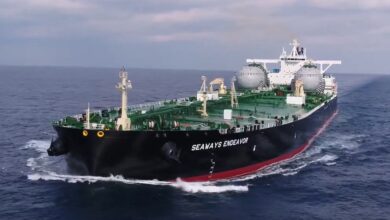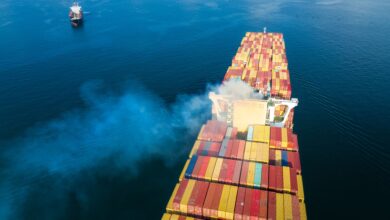Other FreightWaves Products
Greg Miller
Shipping and geopolitical risk: Don’t forget about Korean Peninsula
Amid the focus on wars in Europe and the Middle East, North Korea’s threat to key exporting and shipbuilding nations grows.
Panama Canal transits sink to new drought-driven low in December
Monthly canal transits are now much lower than they were in 2015, the year before the Neopanamax locks went into operation.
Container spot rates rocket even higher as Red Sea crisis drags on
Container lines faced overcapacity and huge losses in 2024. Then the Houthis flipped the market in favor of container lines.
Red Sea conflict worsens, forcing more ship detours around Africa
Container-ship diversions from the Red Sea will likely last for months. Are large-scale tanker diversions imminent?
Container lines ‘scramble’ to rent more ships amid Red Sea crisis
Houthi attacks have been a plus for shipping rates. The latest to benefit: Owners of container vessels that can be rented to shipping lines.
Container lines had rough Q4 before Red Sea-driven rate rebound
The upsurge in rates due to ship diversions did not come soon enough to rescue container lines’ fourth-quarter results.
As Red Sea risk spooks container shipping, tankers remain unfazed
Red Sea escalation would juice tanker rates, but rates would fall if the conflict spilled into the Strait of Hormuz.
December imports surprisingly high amid Panama, Suez Canal woes
U.S. imports kept chugging along, despite all the talk of supply chain problems due to Red Sea attacks and Panama’s drought.
West Coast shipping rates surge as Red Sea fallout goes global
The combination of Red Sea detours and Panama Canal restrictions is having a knock-on effect: higher Asia-West Coast rates.
Container shipping rates spike as Red Sea crisis draws first blood
Imports to Europe and the U.S. East Coast face heavy delays as Operation Prosperity Guardian fails to bring shipping back to the Red Sea.
Shipping shares outpaced S&P 500 amid 2023’s rising stock market
Tanker stocks rose as expected in 2023, container shipping shares surprised to the upside, and dry bulk stocks lagged the pack.
How safe is Red Sea? Different shipping lines have different answers
Shipping stocks are under pressure as some ocean carriers show faith in military protection from Red Sea attacks.
Top ocean shipping stories of 2023: War, drought and detours
Ocean shipping kept the world’s cargo flowing amid two wars and disruptions at both the Panama and Suez canals.
US-led forces in Red Sea will be defensive ‘highway patrol’
The key question for container shipping rates: How soon can Operation Prosperity Guardian woo traffic back to the Red Sea?
Red Sea fallout much greater for containers than tankers, bulkers
Container ships have forsaken the Red Sea route but many bulk commodity vessels continue to transit the danger zone.
Red Sea chaos should boost tanker and container shipping rates
A growing number of ship operators are refusing to transit the Red Sea and taking a very long detour around Africa instead.
Why attacks on container ships caused container stocks to jump
Container-ship route diversions — first to avoid the Panama Canal, now to avoid Red Sea chaos — could help offset rate pressure from newbuilding deliveries.
Panama Canal transits plunge as larger ships are turned away
Panama’s drought initially affected transits through the smaller locks. The pain has now spread to the larger Neopanamax locks.
How Venezuelan invasion of Guyana could impact tanker shipping
As war rages in Europe and the Middle East, a new flashpoint in South America could pose more complications for shipping.
Container shipping outlook 2024: Rising risk of delays, disruptions
Next year, U.S. importers must navigate canal restrictions, diversions from the Red Sea, more canceled sailings and, possibly, a port strike.
US imports dragged down by seasonality, Panama Canal crisis
Imports have held up surprisingly well this year, but peak season’s end and canal restrictions are finally curbing volumes.
America’s energy boom: Crude exports soar to record high
U.S. crude exports have never been higher. Overseas buyers are incentivizing American producers to pump more “black gold.”
‘Astronomical’ gains for dry bulk shipping but rally looks fleeting
Commodity shipping has a well-deserved reputation for extreme volatility. The rise and expected fall in dry bulk is a case in point.
Another Panama Canal red flag: Spiking product tanker rates
U.S. diesel exports to South America’s west coast are heavily exposed to Panama Canal delays. Tanker rates have skyrocketed.
No reservation at Panama Canal? Prepare for a long wait
As the Panama Canal scales back on reservation slots, more ships without reservations wait longer to get through.
Bankrupt Bed Bath & Beyond files $100M+ mega-claim against MSC
MSC, the world’s largest shipping line, faces the largest-ever shipper claim for alleged damages suffered during the supply chain crisis.
Zim container ships divert as threat to Israel-linked vessels mounts
There has been a surge of attacks and threats targeting Israel-linked ships, including one incident where the U.S. Navy came to the rescue.
‘Dire’ scenario for shipping lines more likely as spot rates fall back
Time is running out for container lines as contract rate renewal season nears and spot rates fail to recover.
Yet another shipping ‘chokepoint’ risk as Yemen rebels attack
Panama Canal restrictions force more ships to transit the Bab el-Mandeb Strait off Yemen, where they face a hijacking risk.
Creditor challenges bankruptcy plan of ILWU dockworkers union
Terminal operator ICTSI has not given up its quest for tens of millions in damages from the West Coast longshore union.
China and global trade: Why stimulus is MIA and risks are rising
The era of rapid Chinese growth and large-scale government intervention is over, says China Beige Book CEO Leland Miller.
Massive impairment charge drags shipping line Zim to $2.3B loss
Zim’s headline loss looks ugly, but most of the decline was non-cash and it still has ample reserves to weather the downcycle.
Greek owner to sell all container ships, spend $3B on LNG tankers
A fleet of container vessels is up for sale as a company backed by Greece’s Evangelos Marinakis switches its bets to LNG shipping.
Panama Canal crisis forces US farm exports to detour through Suez
U.S. agribulk exports to Asia are taking the longer route via the Suez Canal due to Panama transit restrictions.
Shipping line Hapag-Lloyd suffers ‘big miss’ as Q3 profits slump
Cargo volumes are holding up, but rising transport capacity is outpacing demand, pushing container shipping rates even lower.
What downturn? US imports still rising, highest since boom
Containerized imports have rebounded strongly in 2023, with October volumes up 33% from February’s low.
Crippling port strike could hit 1 month before presidential election
The union representing East and Gulf Coast dockworkers warned members to prepare for a possible strike starting Oct. 1, 2024.
Maersk cutting 10,000 jobs in face of ‘worsening market conditions’
“This is not a diet. This is a resetting of the baseline,” said Maersk CEO Vincent Clerc on his company’s job cuts.
Shipping braces for impact as Panama Canal slashes capacity
The water crisis at the Panama Canal is getting worse and will force more ships to take much longer routes.
Some shipping lines are still posting 9-figure profits amid downturn
Profits being reported by container shipping lines are down from the stratosphere but many still surpass pre-COVID returns.
East Coast vs. West Coast: More imports shift back to Pacific ports
Now that port labor unrest is over, West Coast container terminals are starting to claw back some of their lost volumes.
Shipping line earnings preview: A mix of black, red and very red ink
Cosco earned more than $800 million in the third quarter, while one analyst expects Zim to lose more than $200 million.
How Middle East war could impact global LNG, LPG shipping
A leading exec in liquefied gas shipping gives his take on war in the Middle East, market fundamentals and shipping stocks.
US pulls trigger on Russian sanctions, blacklists 2 crude tankers
The volume of Russian crude exports is growing and the price is rising, spurring the U.S. and its partners to begin sanctions enforcement.
War in Israel: The new geopolitical flashpoint for ocean shipping
Geopolitics has always been a key driver of global shipping markets. How could the war in Israel affect rates?
US container imports still rising, topping pre-COVID levels
Peak season demand propelled imports higher in September, although softening spot rates point to a fourth-quarter slowdown.
Tanker shipping’s ‘odd couple’ prepares for a divorce
Tanker giant Frontline is poised to dramatically expand its fleet, while Euronav is on a path to privatization.
Tide turning against ‘hyper-dilutive’ shipping stock sales
Investors have been burned for years by dilutive share offerings by micro-cap shipowners. Backlash is building.
How a fight over 2 jobs bankrupted union of 40,000 dockworkers
The Chapter 11 filing of the ILWU dockworkers union dates back to a dispute over two electrician jobs in Oregon a decade ago.
ILWU dockworkers union files for Chapter 11 bankruptcy protection
Just when it looked like West Coast port labor drama had dissipated, the ILWU has filed for bankruptcy protection.
How US military equipment for Ukraine is shipped across Atlantic
A flood of tanks, military vehicles and weapons systems is flowing from the U.S. to Europe. Shipowner ARC plays a pivotal transport role.
Container shipping has a Europe problem and it’s getting worse
Inflation and economic fallout from the war are curbing demand just as a tidal wave of new ship supply hits the water.
How will Russian ban on diesel exports impact global energy trade?
Diesel is an essential fuel for the global economy. The world’s second-largest seaborne supplier, Russia, just halted exports.
Trouble ahead: Container shipping rates sinking further into the red
The recent rate rebound turned out to be fleeting. As rates deteriorate yet again, shipping lines face mounting losses.
For exporters, container shipping still far from pre-COVID ‘normal’
The supply chain crisis is over, but exporters are still paying more — and facing more logistical challenges — than they did before the pandemic.
Newark ship blaze blamed on Ports America-owned loading vehicle
Shipowner Grimaldi says a Jeep Wrangler used to push non-operating automobiles onto the vessel sparked the deadly fire.
Bankrupt Bed Bath & Beyond targets more ‘price-gouging’ shipping lines
The plot thickens in the legal battle between Bed Bath & Beyond and container lines. More carriers are in the crosshairs.
US container imports rise in line with pre-COVID peak season pattern
Now that supply chains are back to normal, the typical effects of seasonality have returned, bringing U.S. imports up.
Time to start worrying again about rising cost of ship fuel
Fuel costs were overshadowed by skyrocketing freight rates amid the supply chain crisis. Now, fuel costs are much more important.
Tanker shipping takes another hit from Saudi, Russian crude cuts
This was supposed to be a banner year for crude tankers, but output cuts and the Russian price cap are keeping rates under pressure.
How have shipping shares performed versus broader stock market?
Have shipping stocks been a good bet? Here’s a look at their performance year to date and versus pre-COVID.
Panama Canal restrictions are rerouting LPG shipping flows
Persistent congestion and higher delays at the Panama Canal could lead to lasting changes in global LPG shipping flows.
Rebound in trans-Pacific container shipping rates has stalled
Asia-U.S. spot shipping rates have pulled back after a strong run-up, implying peak season may have passed its peak.
How much money do shipping CEOs make? Here’s their 2022 pay info
Average CEO compensation rose as ocean shipping company earnings increased, fueled in many cases by share-based compensation.
Shipping ‘traffic jam’ at Panama Canal: Why it’s not a crisis (yet)
Panama’s drought poses a serious challenge to the country’s canal operations, but fallout to global trade remains limited.
Container lines paid out billions in boom-time profits via dividends
Unprecedented supply-demand imbalances amid the pandemic led to historic dividend payouts by container shipping lines.
There’s more coal being shipped by sea than ever before
The global coal trade is thriving, with dry bulk ships busy carrying the loads. As the West consumes less coal, Asia buys even more.
Trans-Atlantic shipping suffers ‘meltdown’ as rates hit new low
Spot ocean shipping rates from Europe to the U.S. held up much longer than trans-Pacific rates. Now they’ve sunk to historic lows.
Shipping line Zim bets big on spot market as losses mount
Zim lost $213 million in the second quarter. Will rising trans-Pacific spot rates help it reverse course in the third?
Sanctions on Russian crude and diesel exports are failing
Price caps have been breached, discounts on Russian exports are dwindling, and more money is flowing to Russian coffers.
July import volumes continue to mirror pre-COVID ‘normal’
Containerized imports are rising seasonally, as expected. This year is on track to top pre-pandemic volumes by low single digits.
Container shipping’s Danaos buys into dry bulk amid rate slump
Investors in Danaos thought they were buying a container shipping stock. Now they’re invested in dry bulk, too.
Asia-US spot rates top contract rates for first time since 2022
After double-digit gains since June, trans-Pacific spot rates have just surpassed contract rates, according to Xeneta data.
Maersk hikes 2023 guidance but warns of ‘years’ of challenges
Despite upgrading its full-year outlook, container shipping giant Maersk no longer sees a second-half demand rebound.
As propane exports break records, LPG shipping stock hits new high
Asian demand for propane continues to build, as does US supply, equating to booming business for LPG tanker owners in the middle.
All-time high: Shares of container company Textainer still rising
Shipping lines are seeing higher cargo volumes and successfully integrating newly built vessels into their fleets, says Textainer’s CEO.
Shipping line ONE’s profits plunge but still top pre-COVID levels
“It is extremely difficult to announce a reasonable business forecast at this time,” said ONE, citing container shipping market uncertainties.
Container shipping giant CMA CGM still earning over billion a quarter
Because container liner profits plummeted off an extraordinarily high peak, some carriers are still posting hefty profits despite huge declines.
Corporate governance in shipping: Who’s been naughty or nice?
Despite ongoing controversy over shareholder treatment, analyst Michael Webber says shipping is doing a better job.
Zim downsizing its container ship fleet as demand disappoints
After rapidly expanding its fleet during the boom, ocean carrier Zim is backpedaling and shedding ships.
Trans-Pacific shipping rates rise as carriers make capacity cuts
Container lines did not manage post-boom vessel capacity as well as expected. In the trans-Pacific, they may be belatedly getting the hang of it.
Q2 container line earnings could surprise to the upside
Expectations for peak season have waned, but container lines may have bounced off the bottom.
Ship fuel spreads and LNG prices fall to lowest levels in years
Spreads between high- and low-sulfur fuels are down to pandemic levels and LNG has become much more economical.
Thousands of ships could use LNG as fuel. Is that a good thing?
Shipowners have invested billions in the LNG fuel option in the belief that it will benefit regulatory compliance and the environment.
Port labor deal in British Columbia collapses, strike resumes
U.S. rail imports from Vancouver and Prince Rupert are imperiled again. ILWU Canada has rejected the proposed dockworkers contract.
Container shipping stocks outperform despite market gloom
Shipping stocks in sectors with high deliveries of new ships are doing better than those with low orderbooks.
Russian crude prices have breached the G-7 price cap. Now what?
Tanker shipping sanctions compliance is getting a lot more complicated as the price of Russian crude oil rises.
It’s over: Labor deal ends strike at Vancouver, Prince Rupert ports
The extended strike in western Canada was beginning to affect U.S. supply chains. Its resolution limits the fallout.
Is IMO 2020 shipping regulation worsening global warming?
Sulfur pollution addressed by IMO 2020 created a health risk, but that pollution had a cooling effect, which has now been reduced.
How ‘historic’ decarbonization deal could inflate future shipping rates
The agreement should keep tanker and bulker orders in check, while increasing the risk of a future carbon tax on container shippers.
US containerized imports still outpacing pre-COVID levels
June volumes of containerized imports were higher than normal and the National Retail Federation predicts more gains ahead.
Over 20 ships wait off Canada ports as dockworker strike drags on
U.S. imports via Canadian ports face rising fallout as the war of words escalates between dockworkers and employers.
Car carrier blaze in New Jersey port will burn ‘for a couple more days’
New Jersey container imports are unscathed “so far” but the port’s automobile trade faces fallout from the ongoing fire.
Container shipping trilemma: Weak rates, new ships, pricey charters
Sluggish demand is capping shipping lines’ income. In response, at least one carrier is reportedly moving to limit losses on legacy charters.
Shipping faces fallout as China’s post-COVID rebound falls flat
Declining demand for Chinese exports and reduced stimulus options threaten bulk commodity import prospects.
How could sooner-than-expected Russian defeat impact shipping?
The Wagner mutiny is drawing attention to what happens after the war in Ukraine ends. When it does, shipping will see major changes.
Controversy swirls over shipping stocks that sink as rates rise
Concerns over highly dilutive share offerings by microcap shipowners have been building for years. The debate just intensified.
Container shipping divide: Cargo rates weaken, ship rents ‘robust’
Trans-Pacific spot shipping rates remain under pressure, slumping back again as U.S. import demand comes up short.
Supertanker rate roller coaster: Surprise spike to $91,000 per day
The International Energy Agency predicts Asia will buy growing volumes of U.S. crude through 2028. That’s good news for supertanker demand.
West Coast port labor deal reached; peak season chaos averted
The U.S. supply chain has dodged a bullet. A new dockworker labor deal will keep the peace at West Coast ports.
















